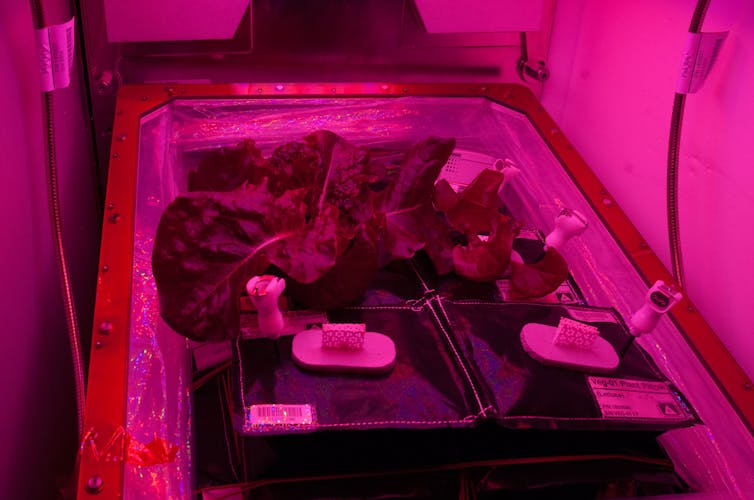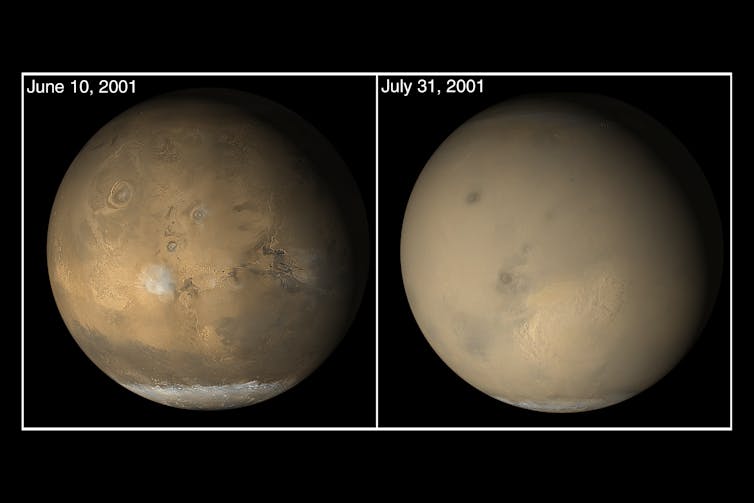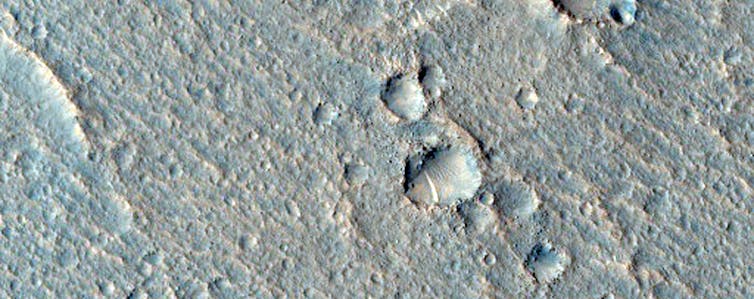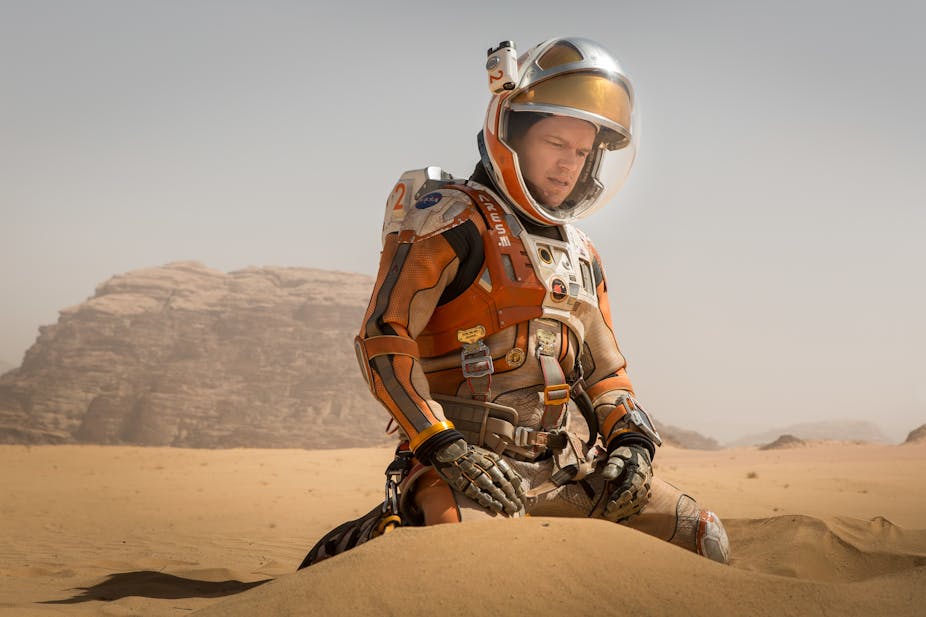“I’m going to have to science the shit out of this,” says astronaut Mark Watney, played by Matt Damon, after being stranded on Mars. That pretty much sums up the tone in Ridley Scott’s new film The Martian, adapted from Andy Weir’s novel, which appears in cinemas this week. Many have already commended the movie for its scientific rigour and Scott has said himself that it is as “accurate as we can possibly get it”.
So does the movie live up to its expectations? Well, the mission design and the hardware are based on actual NASA capabilities and an existing plan to get humans to Mars known as Mars Direct. However, there are parts that are less scientifically accurate. But what the story lacks in scientific rigour, it makes up for with great fiction that could inspire new interest in science.
Growing food in space
The main challenge for Watney is to find a way to grow food on the planet in order to stay alive the four years until NASA’s next planned mission to Mars. While this has of course never been done in real life, it is not entirely unrealistic. In August 2015 astronauts on the International Space Station (ISS) ate lettuce that they had grown in space. This was the first time that humankind had grown and eaten food away from home.
In these so-called “VEGGIE” experiments the crew had been provided with everything they needed: soil, seeds, specific lamps tuned to the requirements of the plants. In The Martain, however, Watney had none of this specially-prepared equipment and, crucially, no soil.

The technical term for loose material covering rock is regolith, which includes the soil that we all know on Earth. Even regolith on Mars is familiar: we have been studying its properties since the 1970s, starting with the Mars Viking missions. NASA’s Phoenix Mars Exploration Rover (MER) has found evidence that the regolith contains crucial minerals for growing plants and is slightly alkaline, suitable for a range of crops – including asparagus and green beans.
Normally potatoes are grown in an acidic soil as this suppresses the effect of pathogens, such as common scab, but also because alkaline soils have a negative effect on the yield of potatoes. Our hero could easily account for this in his calculations for the number of plants required to grow enough food for a set number of days.
But Martian regolith may also contain perchlorates that are not good for human bodies. However, somewhat ironically, they are used as markers for the presence of water. Watney needs additional water for his crops and sets about making this by combining oxygen with hydrogen. To get the hydrogen, Watney catalyses a type of rocket fuel known as Hydrazine, in a somewhat dangerous experiment which would be even more dangerous in real life – as you’d end up with some toxic leftovers.
But exciting new results suggest that water sometimes runs openly on the surface of Mars. So in reality, it would have been safer for Watney to just go and extract it from the regolith itself.
We are seeing the early days of growing food in space. Eventually, if humans are to start living for extended periods on the moon, and eventually Mars, we need to be able to do experiments generating raw materials directly on their surfaces. There are already ideas to test our ability to grow food on the moon in small canisters, including basil and turnips.
Stormy weather
What plunges Watney into peril in the movie is an aborted mission in strong winds. Here on Earth, we use the Beaufort scale to measure wind strength. Gale force winds have speeds up to 74km per hour. To get a sense of what’s that like, imagine putting your head out of a car window when moving at 50 miles per hour. Then try to imagine what it would be like at 100 miles per hour as experienced by Watney and his fellow astronauts on Mars.
On Earth this would be a devastating storm, but not on Mars. The pressure that you feel on your skin when out on a windy day is known as the dynamic pressure. It depends not only on how fast the air is moving, but also on its density. In gale force winds on Earth this pressure is about 250 Pascals. The force this exerts on an average person is about one-third of Earth gravity. This is why you have trouble walking about in gale force winds.
But on Mars, the atmosphere is just 1% of the density of that on Earth, meaning the dynamic pressure is much smaller. Even in Watney’s storm the force on a human being would be tiny — less than one-tenth of Mars’ gravity. The storm that Watney and his crew encounter would only feel like a gentle breeze – not the devastating storm shown in the film.

Despite this, the wind and the sound it produces does actually have an important function in the film – it creates tension and allows us to empathise with Watney and feel his fear.
Finding pathfinder
Even though this is a work of fiction, as a follower of Mars exploration I felt a tingle of excitement as Watney recovered the Mars Pathfinder, buried under a huge pile of dust. Just as NASA follow Watney’s exploits using imaging from orbit in the film, space scientists have also been monitoring the landing sites of Mars spacecrafts, including Pathfinder.
Measurements at the landing site of the Mars lander Phoenix have shown that dust settles out of the atmosphere at a rate of about 0.1 – 1 thousandth of a millimetre per Martian day. Over the 20 years Pathfinder has been on Mars, that only amounts to between 1 mm and 10 mm of accumulated dust. So, in reality, Watney wouldn’t really have needed to do much digging at all. But this dramatic unearthing of Pathfinder pulls at the heart-strings of our exploration of Mars.

All too often in science fiction the characters are placed in impossible situations from which they can only escape by resorting to a kind of scientific deus ex machina. This is certainly not so in The Martian, in which the story has a logically and physically possible resolution.
The Martian is one of an increasing number of Hollywood films that explore the human soul and spirit of humanity while still grounded in science. Another example is how Christopher Nolan and Kip Thorne used Einstein’s theory of General Relativity to tremendous effect in Interstellar. However, The Martian uses science in a different way. It shows what it is to be a scientist. It shows Watney building scientific arguments, doing calculations, facing the outcome of making an error in reasoning – his answers aren’t in the back of the book. This engages audiences with compelling science.
One could easily be critical of the science shown in fiction. But in a push to reflect “real science” in the cinema we shouldn’t surrender strong narratives for the sake of scientific accuracy. To do so denies us the opportunity to tell stories and to show science in action and in unfamiliar settings.

